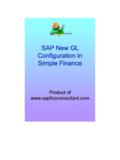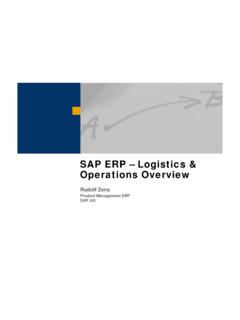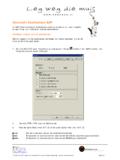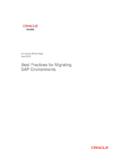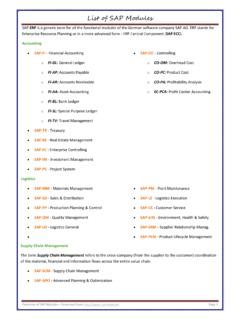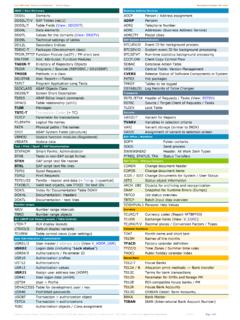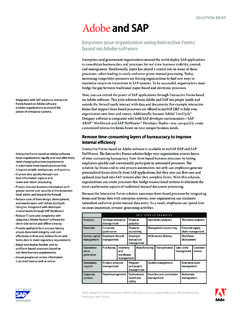Transcription of SAP GRC Process Control - EY
1 Enter SAP GRC. Process Control Contents Introduction Section 1 Section 2 Section 3 Section 4 Section 5 Section 6 Summary Introduction Section 1. What is SAP GRC. Process Control ? 3 5. Section 2 Section 3. Why is there a need How have organizations for a more adaptive benefited from SAP. Process Control GRC Process Control ? framework? 8 11. Section 4 Section 5. How can different Building the business functions benefit from case for SAP GRC. SAP GRC Process Process Control Control ? 12 14. Section 6 Summary Implementing SAP GRC SAP GRC Process Process Control three Control makes life things you must know simpler 21 22. Return to contents Turn page Contents Introduction Section 1 Section 2 Section 3 Section 4 Section 5 Section 6 Summary Introduction Leading companies recognize the importance of practicing strong business ethics and that doing so still supports them to deliver a healthy margin.
2 While integrity in business may have a short-term cost, the long-term value it brings can certainly be worth it. Increasingly, the value attributed to an organization will be based not just on the wealth it creates, but on how it goes about creating it. Effective internal controls and compliance programs are a key component of an organization's code of conduct and ethical framework. Auditors continue to raise the bar with increasingly tougher internal Control examinations and, at the same time, pressure on compliance continues to build with constant regulatory change. Despite these drivers, when it comes to managing internal controls, many organizations still take a sophisticated, yet manual, approach. This is despite the recognition that significant operational effectiveness and efficiencies could be gained through a more automated and centralized Control model.
3 Return to contents Turn page Contents Introduction Section 1 Section 2 Section 3 Section 4 Section 5 Section 6 Summary For SAP customers, SAP GRC Process Control can offer major benefits to key functional areas within a business, including operations, compliance, risk management, controls and internal audit. Once in place, it can act as a controls hub, providing a single, core internal Control system that confirms controls and ongoing compliance across an organization. Because of its capability, SAP GRC Process Control is sometimes unfairly perceived as being big and complicated. Yes, it can be a very powerful tool, but it doesn't need to be complex to implement or run. We've developed this guidance to help you understand SAP GRC Process Control better and to show you how it could make GRC simpler.
4 If the time is right for you to evaluate SAP GRC Process Control , this document is the perfect starting point. Return to contents Turn page Contents Introduction Section 1 Section 2 Section 3 Section 4 Section 5 Section 6 Summary Section 1: What is Understanding how the various components within SAP GRC fit together can be difficult. The following SAP GRC Process Control ? home surveillance and security analogy could help: let's start at the top thinking of Risk Management to consider the various forms of unwanted activity The Open Compliance and Ethics Group (OCEG) defines GRC as and the likelihood of each of these occurring so you the capability to achieve objectives (governance), while addressing can decide what to worry about and where to spend uncertainty (risk management) and acting with integrity (compliance).
5 Your money. Access Control then confirms all your SAP's integrated GRC suite is a comprehensive solution that helps you doors and windows within your home are locked, and manage each area in a unified way using automation, with powerful only certain people have keys and know the right passcodes. Process Control controls whether the monitoring and reporting in real time. alarm is on (as and when required) and confirms the SAP GRC Process Control is a key part of SAP's GRC software. It sits motion detectors, smoke and heat sensors, warning lights and security cameras are all working. Fraud alongside SAP Access Control , SAP Risk Management, SAP Fraud Management can assess what is being recorded Management and SAP Audit Management. Contrary to popular belief, on the cameras along with other data sources, although all are complementary tools, none of these modules are a identify patterns and take precautionary measures, prerequisite to implementing SAP GRC Process Control , which can be such as securing the front gates if an unexpected used on its own.
6 Visitor approaches along the driveway. These complementary components can work together to create a more secure environment, potentially reducing the chance of an incident and helping you manage better if one should occur. Return to contents Turn page Contents Introduction Section 1 Section 2 Section 3 Section 4 Section 5 Section 6 Summary In simple terms, SAP GRC Process Control can act as an organization's controls hub. rt Do epo cu Broadly, it covers five areas: R m en Document: enabling you to document controls, tests of controls and t policies in one place, covering risks and regulations impacting your organization Scope: allowing you to manage risk and compliance by Control tests M o nit to determine scope and test strategies ope Evaluate: evaluating Control design and effectiveness, test policy or Sc compliance, and raise and remediate issues using a range of tools and content Evalu ate Monitor: equipping you with tools to perform automated, exception- based testing and monitoring of controls Report: providing you with actionable insights through analytics and supporting the accountability of individuals through social GRC.
7 Return to contents Turn page Contents Introduction Section 1 Section 2 Section 3 Section 4 Section 5 Section 6 Summary Increased automation and continuous monitoring can lead to reduced It is more than a document cost, more effective use of resources, and better coverage and visibility management system, but it does of risks. As many findings from external auditors confirm, one of the have a central repository with good ways to enhance business operation is to improve the mechanism audit trails within the system and version Control that is able to for monitoring controls and reporting risks. Investments are being made store controls content in a highly to aim to reduce the number and volume of manual Control activities structured, easy-to-use way. that people undertake, as well as to aim to improve the coverage and assurance of the controls.
8 This can bring down the real cost of Control operations, while also helping to increase the business benefit likely to be achieved. Three myth-busting facts about SAP GRC Process Control For organizations using SAP as their core system, SAP GRC Process Control is designed to provide a comprehensive solution that is straightforward to adopt. Interfaces are available to connect SAP GRC. It is more than an IT police and Process Control with both SAP ERP and non-SAP systems without analytics tool, as it goes beyond introducing further complexity. This helps reduce integration challenges. detective, reactive analysis by helping SAP GRC Process Control can offer effective Control management to enable a more preventative, functionality with the potential benefit of improvements to operational proactive controls framework.
9 And management reporting. It can run on a management by exception . basis, meaning that controls are continually monitored with management It doesn't redesign or override current working processes, but testing and by exception and audit logs, and that business Process owners are only controls can help identify ways to make alerted when their actions are needed. internal processes more efficient and effective, and it is also possible to reduce the risk of human errors by introducing more automation. Return to contents Turn page Contents Introduction Section 1 Section 2 Section 3 Section 4 Section 5 Section 6 Summary Section 2: Why is there a need for a more adaptive Process controls framework? In today's constantly changing environment, the need for robust operational processes, regulatory compliance and effective risk management keeps increasing at an unprecedented rate.
10 Expansion into growth markets overseas, diversification into new sectors or product categories and the adaptation to an increasingly digital marketplace have all driven this trend. Furthermore, in today's more ethically responsible environment, stakeholders, auditors and now even customers are demanding greater transparency and more adaptive management practices. Again and again, business values are significantly impacted by a loss of quality or financial risk-related issues. When risk events occur, they are often the result of processes that weren't able to adapt quickly enough and keep pace with a company's growth agenda. Typically, this happens in the finance, reporting and quality assurance arena, and the supply chain and manufacturing production lines. The systems in place to Control risks can't react to the way the organization is changing.










